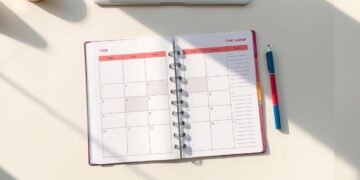Applying to graduate school can feel overwhelming, especially when crafting a compelling statement of purpose. But what truly sets a successful one apart? Is it the structure, the storytelling, or the alignment with academic and professional goals? The answer lies in a combination of all these elements.
This guide provides a comprehensive breakdown of what makes a standout statement. With insights from Ivy League admission coaches like Christine Rose and Kathy Liu, you’ll learn how to avoid common pitfalls and create a document that resonates with admissions committees. Plus, you’ll gain access to a downloadable template and real-world samples analyzed across disciplines.
Whether you’re applying for a master’s or PhD program, this resource covers everything from formatting to storytelling techniques. With a 17-section breakdown and supplemental guidance from a 202,674-word Wordvice resource, you’ll be well-equipped to craft a statement that aligns with your aspirations.
Key Takeaways
- Learn what makes a successful statement of purpose stand out.
- Access a downloadable template and real-world samples.
- Gain insights from Ivy League admission coaches.
- Understand the importance of aligning academic and professional goals.
- Avoid common pitfalls with a detailed 17-section guide.
What is a Statement of Purpose (SOP)?

Understanding the role of this document is crucial for academic success. It’s a 500-1000 word narrative that highlights your qualifications and fit for a program. Unlike undergraduate essays, it focuses on research and professional aspirations.
This document plays a vital role in showcasing your potential beyond transcripts. It helps admissions committees see how your background aligns with their program. With the shift in admissions criteria post-pandemic, its importance has grown significantly.
For example, NYU Stern MBA dropped GMAT requirements, placing more weight on this narrative. This change reflects a broader trend in graduate admissions. Your story now carries more influence than ever before.
Experts suggest dedicating 25% of the content to your background. This section should explain how your experiences shaped your academic trajectory. By doing so, you create a compelling case for your admission.
In today’s competitive landscape, this document is a primary determinant of success. It’s your chance to stand out and demonstrate your commitment to the field. Crafting it with care can make all the difference in your application.
Key Components of a Strong SOP

A standout document for graduate school applications combines clarity, passion, and precision. It’s not just about listing achievements but weaving them into a narrative that aligns with your aspirations. To create a compelling narrative, focus on three core elements: your academic and professional background, career goals, and research interests.
Academic and Professional Background
Your background sets the stage for your narrative. Highlight relevant coursework, research experience, and publications. For example, if you’ve worked 35 hours a week at a nonprofit, quantify its impact. This shows commitment and readiness for advanced study.
Professional experiences like internships or jobs also matter. They demonstrate your practical skills and dedication to the field. Use the CEG’s WHAT/WHY/HOW framework to structure this section. Focus on your accomplishments, motivations, and methods.
Career Goals and Aspirations
Admissions committees want to see a clear vision. Outline your 5-year career plan and how the program aligns with it. For instance, if you aim to work in environmental policy, explain how the program’s resources will help you achieve this.
Be specific about your goals. Avoid vague statements like “I want to make a difference.” Instead, say, “I aim to develop sustainable urban planning strategies.” This shows focus and ambition.
Research Interests and Fit with the Program
Your research interests should reflect intellectual curiosity. Pose specific questions you want to explore. For example, “How can AI improve healthcare accessibility?” This demonstrates critical thinking.
Align your interests with the program’s strengths. Mention faculty members whose work inspires you. For instance, Michigan’s McNair Scholars Program is a great example of faculty alignment. This shows you’ve done your homework and are a good fit.
How to Write a Statement of Purpose for Graduate School
The process of writing a compelling narrative for graduate school involves several key steps. From researching the program to aligning your goals with its mission, each step plays a crucial role in creating a document that stands out. Let’s break down the essential components to ensure your narrative resonates with admissions committees.
Researching the Program and Faculty
Start by diving deep into the program’s website and faculty profiles. Use tools like Google Scholar to explore faculty research and citations. This helps you identify potential mentors and align your interests with their work. For example, if a professor’s research on AI in healthcare excites you, mention it in your narrative.
Reaching out to faculty or current students can also provide valuable insights. Be respectful and concise in your communication. This shows initiative and genuine interest in the program.
Aligning Your Goals with the Program’s Mission
Every program has a unique mission and values. Your narrative should reflect how your goals align with these. For instance, if the program emphasizes innovation, highlight your creative projects or problem-solving skills.
Use the program’s mission statement as a guide. Show how your background and aspirations make you a perfect fit. This demonstrates that you’ve done your homework and are serious about joining their community.
Structuring Your Document Effectively
A well-structured narrative is easy to follow and impactful. Start with a strong introduction that grabs attention. Follow with clear paragraphs that highlight your background, goals, and fit with the program. Use transition phrases like “building on this experience” to maintain flow.
Formatting matters too. Use Times New Roman 12pt font, double-spacing, and 1-inch margins. Save your document as a PDF to ensure consistency across devices. These small details reflect professionalism and attention to detail.
Statement of Purpose (SOP) Template: A Step-by-Step Guide
Crafting a standout graduate school application requires more than just listing achievements. It’s about weaving your experiences into a compelling narrative that resonates with admissions committees. A well-structured template can guide you through this process, ensuring you cover all essential elements.
Introduction: Grabbing the Reader’s Attention
Start with a hook that captures attention. This could be an anecdote, a surprising statistic, or a personal story. For instance, the CEG example uses the phrase “I Will Remember Junia” to create an emotional connection. Your opening should set the tone for the rest of the document.
Place your thesis statement early to guide the reader. This statement should summarize your main argument or purpose. It’s the foundation of your narrative and helps maintain focus throughout.
Main Body: Highlighting Your Qualifications
Organize your qualifications in a clear hierarchy. Start with academic achievements, followed by professional experiences, and then extracurricular activities. This structure ensures your strongest points are highlighted first.
Use the faculty mention formula: “Professor X’s work on Y aligns with my research interests.” This shows you’ve researched the program and are a good fit. Mention specific faculty members whose work inspires you.
How to Structure a Statement of Purpose
The structure of your application narrative can make or break its impact. A well-organized text ensures clarity and keeps the reader engaged. Whether you choose a traditional academic format or a narrative approach, the way you present your ideas matters.
Paragraph-by-Paragraph Breakdown
Start with an origin story that highlights your research interest. This sets the tone and provides context. For example, you could share a pivotal moment that sparked your passion for the field.
Next, provide evidence of your academic preparation. Highlight relevant coursework, research projects, or publications. This demonstrates your readiness for advanced study.
Align your interests with the program’s strengths. Mention specific faculty members and their work. This shows you’ve done your homework and are a good fit.
Include professional experiences that add context to your application. Quantify your impact to show commitment and practical skills.
End with a forward-looking conclusion. Outline your career goals and how the program will help you achieve them. This ties everything together and leaves a lasting impression.
Balancing Personal and Academic Content
Keep personal content to a maximum of 25% of the total text. While sharing your story is important, the focus should remain on your academic and professional qualifications.
For humanities programs, a narrative approach often works best. This allows you to weave personal experiences into your academic journey.
In STEM fields, a more structured and concise format is preferred. Focus on research interests, technical skills, and program alignment.
By striking the right balance, you create a compelling narrative that resonates with admissions committees. A clear and logical flow ensures your application stands out at every level.
How Long Should a Statement of Purpose Be?
Determining the ideal length for your application narrative is a critical step in the process. Most programs expect a document between 500 and 1000 words. This range ensures you provide enough information without overwhelming the reader.
Word Count Guidelines
Top-tier programs often have specific expectations. For example, Yale typically asks for 750 words, while Stanford prefers 900. These averages help you tailor your narrative to meet their standards.
Concision is key. Eliminate redundancy and focus on clarity. Use tools like application tracking spreadsheets to manage requirements efficiently. Remember, one double-spaced page equals about 500 words.
Adhering to Program-Specific Requirements
Programs may have unique guidelines. Some allow appendices for supplemental documents, while others prefer everything within the main text. Always check the program’s website for details.
Font size and spacing also matter. Stick to Times New Roman 12pt and double-spacing for legibility. International programs, like those in the UK, may have different expectations compared to US schools. Research thoroughly to meet their standards.
Statement of Purpose Examples for Graduate School
Examining real-world examples can provide invaluable insights into crafting a standout graduate school application. By analyzing successful narratives, you can identify patterns and strategies that resonate with admissions committees. This section dives into two distinct cases: a humanities program and a STEM program, followed by an analysis of what makes them effective.
Humanities Program Example
One standout example is a narrative accepted to Yale Divinity School. The applicant used a compelling origin story, detailing how their childhood experiences shaped their interest in feminist exegesis. They also highlighted specific faculty members whose work aligned with their research goals, such as the Junia narrative analysis. This approach demonstrated both personal passion and academic fit.
STEM Program Example
Another successful case is an MIT Bioengineering applicant. Their narrative focused on quantifiable achievements, such as research publications and lab experience. They posed specific research questions, like “How can AI improve healthcare accessibility?” This demonstrated critical thinking and alignment with the program’s strengths.
Analysis of Successful Statements
Common traits in successful statements include faculty mentions, clear research questions, and a balance between personal and academic content. Red flags to avoid include vagueness and overloading with personal information. Before-and-after editing comparisons can also highlight the importance of clarity and specificity.
Common Mistakes to Avoid When Writing an SOP
Many applicants unknowingly sabotage their chances by making avoidable errors in their application documents. According to Wordvice, 73% of rejections stem from generic statements. To ensure your narrative stands out, steer clear of these common pitfalls.
Being Too Vague or Generic
Using clichés like “I’ve always loved…” can make your narrative sound uninspired. Admissions committees look for specificity and authenticity. Instead of broad statements, focus on unique experiences that shaped your academic journey.
For example, instead of saying you’re passionate about research, describe a specific project and its impact. This approach demonstrates depth and commitment.
Overloading with Personal Information
While sharing personal stories can add depth, overloading your narrative with unrelated details is a common issue. Trauma dumping, for instance, can distract from your academic and professional qualifications.
Strategic vulnerability, on the other hand, highlights challenges you’ve overcome without overshadowing your achievements. Keep personal content to a maximum of 25% of the total text.
Ignoring Program-Specific Guidelines
Failing to follow program requirements is a critical mistake. This includes exceeding page limits, misspelling faculty names, or submitting incorrect file formats. Such errors can signal a lack of attention to detail.
Always double-check guidelines and tailor your narrative to each program. Mention specific faculty members and align your goals with the program’s mission to show you’ve done your homework.
By avoiding these mistakes, you can craft a compelling narrative that resonates with admissions committees. Paying attention to detail and staying authentic will significantly improve your chances of success.
Tips for Writing an Engaging SOP
To create an engaging document, focus on clarity, precision, and storytelling. Admissions committees look for narratives that are easy to follow yet impactful. By using the right techniques, you can make your application stand out from the rest.
Using Clear and Concise Language
Clarity is essential when writing for academic readers. Avoid jargon unless it’s field-specific and necessary. Use active voice to make your sentences more direct and engaging. For example, instead of saying, “The project was completed by me,” say, “I completed the project.”
CEG recommends incorporating uncommon vocabulary where appropriate. This adds depth to your writing without making it inaccessible. Tools like the Hemingway App can help you achieve a readability score that appeals to admissions committees.
Incorporating Specific Examples
Specific examples add credibility to your narrative. Instead of making broad claims, quantify your achievements. For instance, “I increased efficiency by 40%” is more impactful than “I improved processes.”
Use storytelling devices like foreshadowing or callbacks to create a cohesive narrative. Mention how your experiences shaped your academic and professional goals. This helps readers connect with your journey.
Focusing on the Benefits to the Program
Admissions committees want to see how you’ll contribute to their program. Highlight your research interests and how they align with faculty expertise. For example, “Professor X’s work on Y aligns with my goal to explore Z.”
Frame your narrative around the program’s mission. Show how your skills and experiences will make a positive impact. This demonstrates that you’ve done your homework and are a good fit for their community.
How to Format a Statement of Purpose
Proper formatting is often overlooked but plays a crucial role in making your application stand out. A well-structured document ensures readability and professionalism, which can leave a lasting impression on admissions committees. Let’s break down the key elements of formatting to help you create a polished application.
Font, Margins, and Spacing
Adhering to standard formatting rules is essential. Use Times New Roman 12pt font for clarity and professionalism. Set 1-inch margins on all sides to ensure your text is neatly framed. Double-spacing is preferred for readability, allowing reviewers to easily navigate your document.
Accessibility is also important. Choose ADA-compliant fonts like Arial or Calibri if the program allows. These fonts are easier to read for individuals with visual impairments, ensuring your application is inclusive.
Headers and Paragraph Separation
Headers should include your name, the program you’re applying to, and the date. Place this information at the top of the first page for easy reference. Use consistent formatting for headers, such as bold or slightly larger font size.
Paragraph separation is equally important. Leave a blank line between paragraphs to improve readability. Avoid indenting the first line of each paragraph, as this can make the document look cluttered.
File Formats: Word vs. PDF
Submitting your document in the correct format is critical. PDF is the preferred choice as it preserves formatting across devices. Ensure hyperlinks are active if included, but avoid overloading your document with unnecessary links.
For international programs, check whether they require A4 or Letter paper size. Additionally, be cautious when submitting via cloud platforms. Verify that your document is accessible and formatted correctly after upload.
By paying attention to these details, you can create a professional and polished application that stands out. Proper formatting reflects your commitment to excellence and attention to detail.
The Role of Research in Crafting an SOP
Research plays a pivotal role in shaping a compelling graduate school application. It’s not just about showcasing your achievements but demonstrating how your goals align with the program’s mission. By diving deep into the program’s values and faculty expertise, you can create a narrative that resonates with admissions committees.
Understanding the Program’s Values
Start by decoding the program’s mission statement. This helps you understand what they prioritize, whether it’s innovation, diversity, or research excellence. Aligning your goals with these values shows that you’ve done your homework and are a good fit.
Monitor department news and curriculum patterns. These indicators reveal the program’s focus areas and can help you tailor your application. For example, if the program emphasizes interdisciplinary research, highlight your cross-disciplinary experiences.
Identifying Key Faculty and Their Work
Faculty research is a cornerstone of your application. CEG advises reading at least five publications from key faculty members. Use tools like Google Scholar to track their work and set alerts for new publications.
Mention specific faculty members whose research aligns with your interests. For instance, “Professor X’s work on Y aligns with my goal to explore Z.” This demonstrates your commitment and fit at a deeper level.
Additionally, analyze funding sources and alumni trajectories. These insights can reveal the program’s strengths and how they support students’ career goals. By understanding the program’s culture and resources, you can craft a narrative that stands out.
Aligning Your SOP with Your Career Goals
Mapping your career aspirations within your application narrative can significantly enhance its impact. Admissions committees want to see a clear connection between your past experiences, current goals, and future ambitions. This alignment demonstrates focus and commitment, making your application stand out.
Short-Term vs Long-Term Objectives
Your narrative should outline both short-term and long-term goals. Short-term objectives might include gaining specific skills or certifications, while long-term aspirations could involve leadership roles or global impact. For example, you might aim to complete a certification in data analytics within a year while planning to lead a tech startup in five years.
Mapping a post-grad timeline helps clarify these objectives. Whether you choose an industry or academia path, your narrative should reflect a logical progression. Mentioning professional organization memberships or skill gap addressing strategies can further strengthen your case.
Demonstrating Commitment to the Field
Commitment to your chosen field is a key factor in admissions decisions. Highlight experiences that show your dedication, such as internships, research projects, or volunteer work. For instance, if you’re applying to a business program, discuss how you’ve applied theoretical knowledge in real-world scenarios.
Ethical commitment statements can also resonate with committees. Share how you plan to address global challenges or contribute to your field’s advancement. This not only shows passion but also a sense of responsibility.
By aligning your narrative with your career aspirations, you create a compelling case for your admission. This approach ensures your application is both authentic and impactful.
How to Tailor Your SOP for Different Programs
Tailoring your application for different programs ensures it resonates with each unique audience. Admissions committees look for candidates who demonstrate a clear understanding of their specific values and goals. By customizing your content, you can show why you’re the perfect fit for their program.
Customizing Content for Each Application
Start by creating an application tracking matrix. This helps you organize details like deadlines, requirements, and unique features of each program. Use keyword mirroring techniques to align your language with the program’s mission and values. For example, if a program emphasizes innovation, highlight your creative problem-solving skills.
Mention unique facilities or resources that set the program apart. This shows you’ve done your research and are genuinely interested. Comparative advantage analysis can also help you identify what makes you stand out compared to other applicants.
Highlighting Program-Specific Fit
Admissions committees want to see how you’ll contribute to their community. Use CEG’s Applicant-Program Fit (APF) concept to align your goals with the program’s strengths. Mention specific faculty members and their work that inspires you. This demonstrates a deep connection to the program.
In addition, analyze rejection post-mortems and waitlist conversion tactics to refine your approach. Scholarship alignment methods can also strengthen your case by showing how you’ll leverage their resources to achieve your goals. By tailoring your application in this way, you’ll create a compelling narrative that stands out.
The Importance of Proofreading and Editing
Polishing your application is as crucial as crafting it. Even the most compelling narrative can lose its impact due to overlooked errors or unclear phrasing. Proofreading and editing ensure your document is professional, coherent, and error-free.
Checking for Grammar and Spelling Errors
Grammar and spelling mistakes can distract readers and undermine your credibility. Use tools like Grammarly or Hemingway Editor to catch common errors. Peer review protocols can also help identify issues you might miss.
Text-to-speech verification is another effective method. Hearing your words aloud can reveal awkward phrasing or typos. Consistency checks, such as verifying date formats, ensure your document is polished and professional.
Ensuring Clarity and Coherence
Clarity and coherence are essential for a strong application. Avoid overly complex sentences or jargon that might confuse readers. Sensitivity reader considerations can help ensure your tone is appropriate and inclusive.
Version control systems prevent mix-ups during revisions. Follow the final 24-hour rule: review your document one last time before submission. This ensures you catch any last-minute issues.
By dedicating time to proofreading and editing, you can elevate your application and make a lasting impression on admissions committees.
Using Feedback to Improve Your SOP
Receiving and incorporating feedback is a critical step in refining your application. It helps you identify blind spots and ensures your narrative is clear and compelling. According to CEG, a minimum of seven revisions is recommended to achieve a polished final draft.
Seeking Input from Mentors and Peers
Start by sharing your draft with trusted mentors and peers. Use feedback question frameworks to guide their input. For example, ask, “Does my career vision align with the program’s mission?” This ensures you receive actionable insights.
Track changes etiquette is essential when revising. Use tools like Google Docs or Microsoft Word’s “Track Changes” feature to manage edits efficiently. This process helps you maintain clarity and avoid confusion during revisions.
Revising Based on Constructive Criticism
When revising, prioritize conflicting advice resolution. Not all feedback will align, so focus on suggestions that strengthen your narrative. Cultural translation needs may also arise if you’re applying to international programs. Ensure your tone and language resonate with the target audience.
Blind review techniques can provide unbiased insights. Ask reviewers to assess your draft without knowing your identity. This reduces bias and highlights areas for improvement. Rubric-based scoring further refines your application by aligning it with program-specific criteria.
Finally, conduct version comparison exercises. Compare your initial draft with the final version to measure progress. This not only highlights your growth but also ensures your application has the desired impact.
Conclusion: Crafting a Winning Statement of Purpose
Creating a standout application requires focus, preparation, and a clear vision. Start your journey with a 3-month preparation timeline to ensure every detail is polished. Utilize resources like style guides and webinars to refine your narrative and align it with program expectations.
Remember to prioritize your mental health during this process. Crafting a successful statement purpose can be demanding, so take breaks and seek support when needed. Use a submission checklist to avoid last-minute errors and ensure all requirements are met.
After submission, stay proactive. Follow up with programs if necessary and prepare a waitlist action plan. Embrace a continuous improvement mindset, as this process is not just about one application but your long-term growth. With dedication and the right guide, you can craft a narrative that truly stands out.
FAQ
What is a Statement of Purpose?
A Statement of Purpose is a written document that outlines your academic background, career goals, and reasons for applying to a specific graduate program. It helps admissions committees understand your motivations and fit for their program.
Why is a Statement of Purpose important for graduate school admissions?
It provides insight into your aspirations, qualifications, and how you align with the program’s mission. A well-crafted SOP can set you apart from other applicants by showcasing your unique strengths and commitment.
What are the key components of a strong Statement of Purpose?
A strong SOP includes your academic and professional background, career goals, research interests, and how you fit with the program. It should also demonstrate your passion and readiness for advanced study.
How do I write a Statement of Purpose for graduate school?
Start by researching the program and faculty. Align your goals with the program’s mission, and structure your SOP effectively with a compelling introduction, detailed main body, and strong conclusion.
How long should a Statement of Purpose be?
Typically, it should be between 500 to 1,000 words. However, always check the specific requirements of the program you’re applying to, as guidelines may vary.
What are common mistakes to avoid when writing a Statement of Purpose?
Avoid being vague, overloading with personal details, or ignoring program-specific guidelines. Focus on clarity, relevance, and demonstrating your fit for the program.
How can I make my Statement of Purpose engaging?
Use clear and concise language, incorporate specific examples, and focus on how you can contribute to the program. Show enthusiasm and a genuine connection to the field.
What is the best way to format a Statement of Purpose?
Use a professional font like Times New Roman or Arial, set margins to 1 inch, and double-space the text. Save your document in the required format, usually Word or PDF.
How important is research in crafting a Statement of Purpose?
Research is crucial. Understanding the program’s values, faculty, and research opportunities allows you to tailor your SOP and demonstrate a strong fit.
Should I tailor my Statement of Purpose for different programs?
Yes. Customize your SOP for each application by highlighting how your goals align with the specific program’s strengths and mission.
Why is proofreading and editing important for a Statement of Purpose?
Proofreading ensures your SOP is free of grammar and spelling errors, while editing improves clarity and coherence. A polished document reflects professionalism and attention to detail.
How can feedback improve my Statement of Purpose?
Seeking input from mentors or peers provides fresh perspectives and helps identify areas for improvement. Constructive criticism can strengthen your SOP and make it more impactful.





